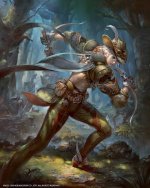Beefermatic
Hero
I really like certain aspects of this, but think it has some obvious issues, the formatting is great, but I think the ki and prana pools are a bit redundant but no more so than the magus and their arcane pool. I think Inedia and Anoxia are a bit much, and honestly I didn't want them to just be better in all ways than the monk and also be able to match a fighter's specialization, but I don't dislike this. However, here's my feedback and I won't be generally using this, and here's why:I have modifier the Prana Warrior for my campaing, essentially giving the Brawler's Cunny and Martial Trainig of the Brawler, the AC bonus and Ki pool of the base monk (but Cha based), reworking the Flurry with the Flurry of the Legendary Monk, giving Inedia and Insomnious and reworking Adaptation with the options gived bt Upper_Krust in my thread of the Environment rules of a black hole (Help for the Environment rules for a Black Hole 3.5E/PF1). What do you think?
Prana Warrior
Dedicated and fanatical warriors, Prana Warriors learn to harness their internal energy as a monk but instead of using it for the cultivation of health and enlightenment, use it to tap into their internal energetic reservoir and use it as fuel to make them far more powerful than their peers. This abuse of the spirit comes with a heavy cost as they begin to age ever faster losing 1% of their total lifespan with every level gained.
Alignment: Any.
Hit Die: d12.
Starting Wealth: 5d6 × 10 gp (average 175 gp.) In addition, each character begins play with an outfit worth 10 gp or less.
Starting Age: As a monk.
Class Skills
The Prana Warrior’s class skills are Acrobatics (Dex), Climb (Str), Craft (Int), Escape Artist (Dex), Handle Animal (Cha), Intimidate (Cha), Knowledge (religion) (Int), Knowledge (planes) (Int), Perception (Wis), Profession (Wis), Ride (Dex), Sense Motive (Wis), and Swim (Str).
Skill Ranks per Level: 4 + Int modifier.
Class Features
All of the following are class features of the Prana Warrior.
Weapon and Armor Proficiency
Prana Warrior is proficient with all simple and martial weapons, all monk weapons, all firearms, all plasma weapons and with light and medium armors but with no shields.
AC Bonus (Ex)
When unarmored and unencumbered, the Prana Warrior adds his Charisma bonus (if any) to his AC and his CMD. In addition, a Prana Warrior gains a +1 bonus to AC and CMD at 4th level. This bonus increases by 1 for every Prana Warrior monk levels thereafter, up to a maximum of +5 at 20th level.
These bonuses to AC apply even against touch attacks or when the Prana Warrior is flat-footed. He loses these bonuses when he is immobilized or helpless, when he wears any armor, when he carries a shield, or when he carries a medium or heavy load.
Damage Reduction (Ex)
At 1st level, a Prana Warrior gains damage reduction. Subtract 1 from the damage the Prana Warrior takes each time he is dealt damage from a weapon or a natural attack. At 5th level, and every five Prana Warrior levels thereafter (10th, 15th, and 20th level), this damage reduction rises by 1 point. Damage reduction can reduce damage to 0 but not below 0.
Flurry (Ex)
At 1st level, a Prana Warrior can make a flurry as a unique full-attack action. When making a flurry, the Prana Warrior can make one additional attack at his highest base attack bonus. When using this ability, the Prana Warrior must make these attacks with his unarmed strikes. Unlike a normal full attack, a Prana Warrior cannot make any attacks which would be made at a reduced base attack bonus (a 6th level a Prana Warrior could make two attacks at +6, but not a third at +1), including those granted by feats such as Improved Two-Weapon Fighting.
At 6th level, and every five levels thereafter, a Prana Warrior can make an additional attack at his highest base attack bonus whenever he make a flurry (3 at level 1st, 4 at level 6th, 5 at level 11th, etc.). This stacks with the first attack from this ability and additional attacks from haste and similar effects. A Prana Warrior cannot benefit from other abilities or effects which would grant additional attacks while using flurry except haste effects or the Two-Weapon Fighting feat. When using the Flurry and the Two-Weapon Fighting feat, the Prana Warrior does not take the usually -2 to attack rolls. A Prana Warrior applies his full Strength bonus to his damage rolls for all successful attacks made with flurry. A Prana Warrior may substitute disarm, sunder, and trip combat maneuvers for unarmed attacks as part of a flurry. Flurry count as the flurry of blows class feature.
Martial Training (Ex)
At 1st level, a Prana Warrior counts his total A Prana Warrior levels as both fighter levels and monk levels for the purpose of qualifying for feats. He also counts as both a fighter and a monk for feats and magic items that have different effects based on whether the character has levels in those classes (such as Stunning Fist and a monk’s robe). This ability does not automatically grant feats normally granted to fighters and monks based on class level, namely Stunning Fist.
Prana Blast (Su)
At 1st level, a Prana Warrior can unleash blasts of pure Life Energy, these use Prana Points to manifest and can be modified in a number of ways, these attacks deal bludgeoning damage equal to the dice indicated and stack with Prana Effect dealing Aura or Strike Damage with each attack. Unless stated the use of Prana Blast is a standard action. The damage count as magic for overcome damage reduction. A Prana Warrior can manifest his Prana Blast in the following ways:
-Base:
Prana cost: 1 Prana per dice dealt, cost caps out at 8 dice
The most basic Prana attack, a ranged blast of charged heat, pressure and light. A Prana Warrior deals 1d10 Bludgeoning Damage + Charima Modifier, at a range of range of 30 ft. as a ranged touch attack, every 5th level this attack doubles in power and range. Boosting effects can be stacked if applicable, damage can be Maximized for double the Prana spent.
-Area Blast:
Prana cost: ½ base Prana Blast
Range: 5 ft. radius burst for every 2 levels centered on the Prana Warrior
As a full-round action, a Prana Warrior unleashes a charged aura of Prana that deals half base Prana Blast damage and sends foes hurtling 5 ft. per level feet away from the Prana Warrior. If an obstacle stops the hurled creature before it travels the whole distance, the hurled foe and the obstacle struck each take 1d6 points of damage per 10 feet of distance remaining and the foe is knocked prone in the space adjacent to the obstacle. A Reflex Save DC 10 + ½ Prana Warrior level + Prana Warrior Charisma modifier reduces the damage by half and negate the hurling effect.
At 4th level the Prana Warrior can use the following effects:
-Barrage:
Prana cost: 0
A Prana Warrior can opt to use small Prana Blasts in lieu of normal attacks, this use of Prana blast uses no Prana and hits with a ranged touch attack out to a range of equal to base Prana Blast range, but deals damage as an unarmed attack with no Strength modifier, this cannot be stacked with any other ability except Controlled Blast and Constant Stream.
-Linear Blast:
Prana cost: base Prana Blast +2 Prana
Range 100 feet + 10 ft. per level (Medium)
The Prana Warrior can fire his Prana Blast as a Line dealing standard damage or maximum damage for additional Prana cost equal to base Prana Blast cost. All creatures and objects within the area take the damage. A Reflex save DC 10 + ½ Prana Warrior level + Prana Warrior Charisma modifier reduces the damage by half.
At 8th level the Prana Warrior can use the following effect:
-Explosive Blast:
Prana cost: base Prana Blast +4 Prana
Range 400 ft. + 40 ft./level (long) 25 ft. + 5 ft./2 levels (Short) radius explosion
The Prana Warrior can trigger a massive explosion at a point of his choosing within a long range dealing standard damage or maximum damage for additional Prana cost equal to base Prana Blast cost. All creatures and objects within the area take the damage. A Reflex save DC 10 + ½ Prana Warrior level + Prana Warrior Charisma modifier reduces the damage by half.
At 12th level the Prana Warrior can use the following effect:
-Constant Stream:
Prana cost: 1
The Prana Warrior can empower his other Prana Effects to wear down and ignore damage reduction after the first round by concentrating and keeping an unending barrage of attacks upon a single foe. This ability can be used with Barrage and Prana Effect. If his first round failed to deal damage due to Damage Reduction blocking all damage dealt; the following round the damage dealt is deducted from the DR. (if the enemy had damage reduction 40 and you dealt 30 damage, the following round they would only be treated as having damage reduction 10). If the Prana Warrior fails to hit the target at least once per round, the ability must be reestablished starting from scratch.
At 16th level the Prana Warrior can use the following effect:
-Charged Blast:
Prana cost: base Prana Blast
The Prana Warrior can, as a full-round action, charging his energy into a single massive attack. Each round the attack is charged, the base Prana Blast dice is added to a single melee attack and once released it deals all the accumulated damage dice all at once to a target (or targets if the Prana Warrior can damage multiple creatures with a single melee attack). The blast can be charged to a maximum of ¼ the Prana Warrior’s Constitution Modifier (minimum +1) before needing to be fired but can be held, using a standard action, for 1 Prana per round until ready to be fired.
At 18th level the Prana Warrior can use the following effect:
-Swift Area Blast:
Prana cost: double base Prana Blast, or Prana Blast cost
The Prana Warrior can use Area Blast as a swift action for double base Prana Blast cost and his base Area Blast can now be used as a standard action for base Prana Blast cost.
At 20th level the Prana Warrior can use the following effect:
-Controlled Blast:
Prana cost: base Prana Blast +5, or 5 Prana for Barrage
The Prana Warrior can make a standard Barrage, or Charged Prana Blast chase foes and strike unerringly like a magic missile but dealing the Prana Blast damage. Actually this removes the need for the attack roll. Because of the necessity of finess in the control, this effect has a range equal to half the normal range of Base Prana Blast. The attack is still subject to concealment or cover and is subject to a Shield spell when used with Barrage.
Prana’s Cunning (Ex)
If the Prana Warrior's Intelligence score is less than 13, it counts as 13 for the purpose of meeting the prerequisites of combat feats.
Prana Pool (Su)
A Prana Warrior gains a reservoir of internal energy he can harness at will. A Prana Warrior has an amount of Prana equal to his 3 + his Charisma Modifier at level 1st and gains his Charisma Modifier (minimum 1), every level added to this reservoir. He may use any number of Prana Points per round but only equal to his level + Constitution Modifier maximum for any one ability.
Prana Use (Su)
Prana Warriors can manifest a number of powerful effects with their mastery of Prana, their own Life Force. He gains a Perfection bonus to AC, Saves, Attack, CMB and CMD equal to his Charisma Modifier.
Soul of Kindling (Ex)
By burning their soul essense they slowly destroy themselves burning themselves out. Every level the Prana Warrior gains reduces his total natural lifespan by 1%.
Two Weapon Fighting (Ex)
At 1st level, a Prana Warrior gains the Two-Weapon Fighting feat, even if he do not meet the prerequisites for it.
Unarmed Strike
At 1st level, a Prana Warrior gains Improved Unarmed Strike as a bonus feat. A Prana Warrior’s attacks may be with fist, elbows, knees, and feet. This means that a Prana Warrior may make unarmed strikes with his hands full. There is no such thing as an off-hand attack for a Prana Warrior striking unarmed. A Prana Warrior may thus apply his full Strength bonus on damage rolls for all his unarmed strikes.
Usually a Prana Warrior’s unarmed strikes deal lethal damage, but he can choose to deal nonlethal damage instead with no penalty on his attack roll. He has the same choice to deal lethal or nonlethal damage while grappling.
A Prana Warrior’s unarmed strike is treated as both a manufactured weapon and a natural weapon for the purpose of spells and effects that enhance or improve either manufactured weapons or natural weapons.
A Prana Warrior also deals more damage with his unarmed strikes than a normal person would, as shown above on Table: Prana Warrior. The unarmed damage values listed on Table: Prana Warrior are for Medium monks. A Small Prana Warrior deals less damage than the amount given there with his unarmed attacks, while a Large Prana Warrior deals more damage; see Table: Small or Large Monk Unarmed Damage on the monk page (the Prana unarmed strike damage scale like a monk).
Fast Movement (Ex)
At 2nd level, all the Prana Warrior’s speed are faster than the norm for his race by +10 feet. This benefit applies only when he is wearing no armor, light armor, or medium armor, and not carrying a heavy load. Apply this bonus before modifying the Prana Warrior’s speed because of any load carried or armor worn. This bonus stacks with any other bonuses to the Prana Warrior’s land speed. At 4th level and every two Prana Warrior levels thereafter this bonus increase by 10 ft.
Flight (Su)
At 3rd level, a Prana Warrior can spend 1 Prana as a swift action for gain a flight speed of double his land movement speed for 1 hour (perfect maneuverability).
Constant Training (Ex)
At 3rd level, the Prana Warrior constantly does rigorous and grueling exercise and bodily conditioning: every 3 levels he gains a +2 inherent bonus to 1 physical stat of his choice. He must train 2 full hours every day to receive these bonuses. If he foregoes his training for 2 full months, his Constant Training bonuses are lost and he must train for an amount of time equal to the time spent away from his training to recover these bonuses.
Ki Pool (Su)
At 4th level, a Prana Warrior gains a pool of ki points, supernatural energy he can use to accomplish amazing feats. The number of points in a Prana Warrior’s ki pool is equal to ½ his Prana Warrior level + his Charisma modifier. As long as he has at least 1 point in his ki pool, he can make a ki strike.
At 4th level, ki strike allows his unarmed attacks to be treated as magic weapons for the purpose of overcoming damage reduction.
At 7th level, his unarmed attacks are also treated as cold iron and silver for the purpose of overcoming damage reduction.
At 10th level, his unarmed attacks are also treated as alignment weapons (same alignment of him) for the purpose of overcoming damage reduction.
At 16th level, his unarmed attacks are treated as adamantine weapons for the purpose of overcoming damage reduction and bypassing hardness.
At 20th level, his unarmed attacks are treated as epic weapons for the purpose of overcoming damage reduction.
By spending 1 point from his ki pool, a monk can do one of the following:
The ki pool is replenished each morning after 8 hours of rest or meditation; these hours do not need to be consecutive.
- Make one additional attack at his highest attack bonus when making a flurry of blows attack, or
- Increase his speed by 20 feet for 1 round, or
- Give himself a +4 dodge bonus to AC for 1 round.
- Each of these powers is activated as a swift action.
Sunderer (Ex)
At 6th level, a Prana Warrior begin to be able to easily damage their environment, all unarmed attack and Prana Blast they unleash deal double damage to all objects and Hardness is halved against their attacks.
Dimension Hop (Su)
At 7th level, a Prana Warrior becomes very efficient at avoiding incoming attacks and can teleport 25 feet + 5 feet/2 levels (Short Range) as an immediate action for 1 Prana. If the Prana Warrior teleport outside the range of the attack or targeting effect, the attack is negated.
Evasion (Ex)
At 9th level, a Prana Warrior can avoid damage from many area-effect attacks. If a Prana Warrior makes a successful Reflex saving throw against an attack that normally deals half damage on a successful save, he instead takes no damage. Evasion can be used only if the Prana Warrior is wearing light armor or no armor. A helpless Prana Warrior does not gain the benefit of evasion.
Boost (Su)
At 11th level, as a swift action, the Prana Warrior may sheathe himself in a veil of Pranic Fire increasing his Strength, Dexterity, Constitution and Charisma scores by +4 points and double his movement speed for 1 Prana per hour outside of combat and 1 Prana per round in combat.
Haleness (Ex)
At 12th level, the Prana Warrior no longer needs to breathe.
Asunder (Su)
At 13th level, a Prana Warrior’s blows are so strong they deal concussive force with each strike. He deals an additional 1d12 points of Force damage per hit, this applies to all melee and Prana based attacks including Prana Blast and Effect.
Inedia and Insomnious (Ex)
At 14th level, the Prana Warrior no longer needs to eat or sleep.
Shadow Image (Su)
At 15th level, the Prana Warrior learns to move so fast he can create an afterimage, as a free action costing 1 Prana per round, giving him a single ‘Mirror Image’ duplicate that cannot be fooled by magic or true seeing, giving him 50% concealment.
Improved Evasion (Ex)
At 16th level, a Prana Warrior’s evasion ability improves. He still takes no damage on a successful Reflex saving throw against attacks, but henceforth he takes only half damage on a failed save. A helpless Prana Warrior does not gain the benefit of improved evasion.
Fighting Spirit (Ex)
At 17th level, a Prana Warrior can gain temporary hp equal to his Charisma modifier +1 per level, this can be used as part of a Boost and is a free action to use on it’s own. The temporary hit points last 1 minute per Prana Warrior. It can be used for a number of rounds equal to 3 + Constitution modifier per day.
Greater Teleport (Su)
At 19th level, a Prana Warrior, as a full-round action, can fold space to reach any area on the current plane it inhabits (as a greater teleport spell) costing base Prana Blast cost x2 in Prana.
Eternal (Ex)
At 20th level, a Prana Warrior has overcome all the weakness of his body. He no longer die from old age. If he has penalties to his physical ability scores due to aging, he no longer take those penalties. Physically he returns to the way he was in his prime. He still continue to mentally age, and gain all the benefits to her mental ability scores for advanced age. Effectively, this nullify the Soul of Kindling.
Adaption (Ex)
At 20th level, a Prana Warrior gains resistance* to Terrestrial Hazards: Volcano High temperatures, Arctic Freezing Temperatures, Sea Trench Pressures, Lightning Storms, etc.
At 40 level, a Prana Warrior gains immunity to Terrestrial Hazards and resistance to Stellar Hazards: Surface of the Sun, Outer Space, Extreme Pressure Environments (Planetary/Stellar cores), Heavy Gravity, Cosmic Storms, etc.
At 120 level, a Prana Warrior gains immunity to Stellar Hazards and resistance to Dimensional Hazards: Black Holes, Worm Holes, Quasars, Gamma Rays, Time Storms, etc.
At 320 level, a Prana Warrior gains immunity to Dimensional Hazards and resistance to Universal Hazards: Big Bang (planck) effects, Tears in Reality, Cosmic Cysts, Star Plagues, Collapsing Space, etc.
At 1.000 level, a Prana Warrior gains immunity to Universal Hazards and resistance to Multiversal Hazards: Probability Crack, Logic Paradox, Anti-Maxim, the Pleroma space, etc.
*Resistance is different from immunity and the GM’s is the judge to how they are affected by a given phenomenon (to give an example, Sidereals are resistant but not immune to Dimensional Hazard: a black hole might be used to imprison a sidereal with the high EMF essentially functioning as dead-magic zones).
The biggest issue I see, is their Eternal, immortality from old age thing they get at higher levels. Imo, this defeats any drawback for taking the class, but that's sort of why they're extra strong, they pay the ultimate price for gaining that power.
These are supposed to be more like Frieza soldiers, instead of Godlike beings, they're generally lower level hyperboreans without enough power to hang with higher ups, being forced to burn themselves out to be more useful to their commanders in the short term vice a godlike super class with zero flaws. Along with that, they would never normally be able to reach past level 100, so the increase to their adaption wouldn't make sense, moreover to make their adaption leaps and bounds better than even a Time Lord's Immunity hardly stands to reason for a simple class feature, even a thousand levels in.
So, obviously from what I've stated, I believe that this version of the class, with that ability in particular, is super busted strong. The Prana Warrior was never meant to be a 'Super Monk', better in all ways, with zero reason to take the other classes, it was meant to be like someone taking steroids, mass gains but at the expense of your overall health and life ultimately. Just making it able to circumvent that drawback is like giving a fighter 9th level spells for reaching 20th level, or allowing a 20th level Paladin to just act in any way they see fit, it's just not in line and makes no sense for what the class is supposed to be. Imo.
I think I wouldn't mind it so much if it didn't make it so they no longer die from old age, or nullify the Soul of Kindling ability. I actually like the idea that it nullifies the age penalties to physical ability scores, I think that makes sense and I'll probably add that in with mine, it's just the nullification of the biggest flaw with the class part that bugs me and just doesn't make sense.
I will probably use this for certain elite Hyperboreans, and certain Mary Sue types. I like the Ki Abilities, but still feel like those should be monk only powers, likewise the Fighter feat selection, cool as that would be, I don't think it makes sense, they're not really dedicating themselves to a weapon and shouldn't be able to have the same level of finesse or skill as a legit fighter, someone who puts all their effort and focus into their weapons or the same capability to specialize like a a fighter or monk, I just don't think that's fair. Like why play anything else?
I'm really not trying to be sour grapes here, but generally I feel this version gives a class, a class that already had a lot, basically an "I Win" button. It makes an already overpowered class just way too strong. I don't dislike it, i like a lot of the ideas, but I don't think it really lines up except for as a super OP Goku character, for what this class was supposed to originally represent and how they get to this level of power so quickly, I just don't think it matches up.
If you want it for your campaign go nuts, but it's not what I envision, at all, for the class I made at higher levels whatsoever if they simply can circumvent it's downsides and outperform any other melee class. They're supposed to be powerful, but there's supposed to be a cost, and the point was it's supposed to have a downside.
Last edited:








